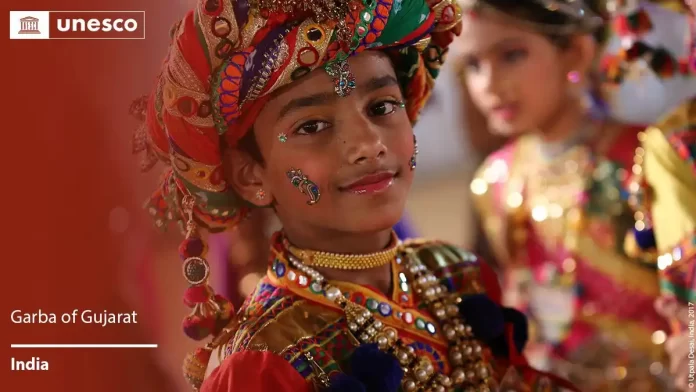Gujarat’s vibrant folk dance, Garba, has captivated audiences for centuries. But on December 6th, 2023, its legacy took a momentous leap, being inscribed on the prestigious UNESCO Representative List of Intangible Cultural Heritage of Humanity. This recognition elevates Garba to the global stage, highlighting its unique cultural significance and ensuring its preservation for future generations.
What is Garba dance?
Garba dance a deeply ritualistic and devotional dance performed during the nine-day Hindu-Brahmin festival of Navratri, dedicated to the worship of the goddess Durga.
The circular movement of the dancers around a beautifully decorated Garba pot, representing the cosmic womb, signifies the cyclical nature of life and creation.
Evolution of Forms
Throughout history, Garba has evolved into various styles, each reflecting the unique cultural nuances of different regions in Gujarat. Here are some of the most prominent forms:
- Kathiyawadi Garba: This fast-paced style is characterized by intricate footwork and rapid twirling, showcasing the athleticism and exuberance of the dancers.
- Saurashtran Garba: More graceful and refined, the Saurashtran Garba emphasizes elegant hand movements and coordinated claps, creating a mesmerizing visual spectacle.
- Adivasi Garba: Rooted in tribal traditions, this form features simpler steps and emphasizes rhythmic chanting and the use of traditional instruments like the dhol and pungi.
A Fusion of Music and Movement
The infectious energy of Garba is fueled by energetic traditional music featuring the rhythmic beats of dhol drums and the melodic tunes of the harmonium and dholki. The intricate footwork, synchronized claps, and elegant hand movements of the dancers create a mesmerizing visual spectacle.
More than Just a Dance
Garba transcends age, gender, and social barriers. It’s a unifying force that brings communities together in a vibrant celebration of faith, tradition, and cultural pride. From young children to seasoned dancers, everyone joins in the joyous revelry, fostering a sense of belonging and inclusivity.
A Celebration of Diversity
Garba boasts diverse regional variations within Gujarat, each with its unique style and cultural nuances. From the fast-paced Kathiyawadi Garba to the graceful Saurashtran Garba, each style reflects the local heritage and traditions, creating a rich tapestry of cultural expression.
A Heritage for the Future
The UNESCO recognition comes at a crucial time, as rapid modernization and globalization threaten the preservation of traditional cultural forms. With this inscription, Garba gains international recognition and protection, ensuring its transmission to future generations.
A Global Phenomenon
Garba has transcended its geographical boundaries, captivating audiences worldwide. From vibrant Bollywood movies to international dance festivals, Garba’s infectious energy and cultural significance have garnered global appreciation.
Beyond the Dance floor
The significance of Garba extends beyond the dance itself. It serves as a powerful symbol of Gujarati identity, cultural heritage, and values. It also provides a platform for promoting social harmony, community spirit, and cultural exchange.
Issues & Challenges
Unfortunately, incidents of harassment and inappropriate behaviour in mixed gender garbas can sometimes mar the joyous atmosphere. It’s important to foster a culture of respect and inclusivity, where everyone feels safe and comfortable expressing their cultural pride.
Organisers can implement various measures, such as dedicated security personnel, clearly defined boundaries, and readily available reporting mechanisms, to create a secure and respectful environment for all.
A Call to Action
While the UNESCO recognition is a significant milestone, it’s only the beginning. The onus now lies on communities, cultural institutions, and individuals to actively engage in the preservation and promotion of this vibrant tradition. This can be achieved through various initiatives, such as:
- Supporting Garba training programs and workshops for all age groups.
- Organizing community Garba events and performances.
- Documenting and archiving Garba traditions and history.
- Promoting research and academic studies on Garba.
- Integrating Garba education into school curriculums.
By actively promoting and preserving safe and harassment free Garba, we can ensure that this vibrant cultural heritage continues to flourish for generations to come.
